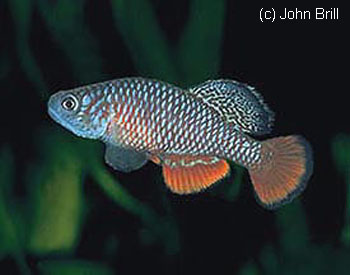|
Dorsal spines (total): 0-0; Dorsal soft rays (total): 15-17; Anal spines: 0-0; Anal soft rays: 15-18. Description: Snout short, flat and broad; in mature males the snout is covered with numerous small tubercles which extend to forehead, edges of adjacent scales and margins of orbits; these tubercles also appear on rays of dorsal and anal fins; mouth directed upwards, lower jaw projecting; teeth in upper jaw conical, sharply pointed, those of outer series largest; teeth in lower jaw mostly coarse with flattened crowns (Ref. 96544). Dorsal fin with 15-17 rays; anal fin with 15-18 rays; origin of dorsal fin over origin of anal except in some distorted ovigerous females where the anal fin is displaced slightly posteriorly; mature males have tips of anal and caudal rays extended to beyond membrane of these fins, a feature not evident in female material; in specimens of the same size there is no significant difference in size of the anal fins, but males have slightly larger dorsal fins, the posterior rays being longer (Ref. 96544). Scales markedly deciduous in preserved material, 26-28 in longitudinal series, lateral line pores absent; scales around body immediately in front of pelvic fins 22-24 (Ref. 96544). Colouration: Colouration of living mature adult males: scale centres iridescent turquoise edged crimson, edging on scales forming a reticular pattern when fully developed; ventrally crimson from midway between insertion of pectoral fins to and along base of anal fin; crimson region broadest between pelvic fins and anal fin; pectoral fins practically transparent, pale olive; pelvic fins crimson tipped with black ; anal fin crimson at base, then a clear band colourless or pale turquoise, the rest of the anal fin, except for the extreme edge where the extended rays are black, being crimson; caudal fin crimson, darker at base, with narrow black band, or, as in some specimens, a colourless posterior border; in either pattern the tips of any extended rays are black; the dorsal fin has membrane pale olive or pale turquoise with crimson to red-brown spots and irregular bands; membrane darker towards extremity with edge turquoise; the pupil of the eye has a narrow golden border, the iris being golden, tinted turquoise in places with traces of pigmented vertical dark bar through eye; chin and throat pale golden olive, operculum turquoise with crimson markins (Ref. 96544). Colouration of living females is drab silvery-grey with pale olive or pale turquoise-tinted fins (Ref. 96544). Preserved specimens are practically featureless; both sexes have numerous small black dots visible through the scales, males being generally darker; the membrane of the dorsal fin is pigmented giving a blotchy effect; the pale band in the anal fin becomes a pigmented band of small dots; the pale band at the posterior extremity of the caudal fin is also pigmented with minute dots, as are extended tips of the rays of the anal fin and articulations of the lepidotrichia of both fins (Ref. 96544). |

